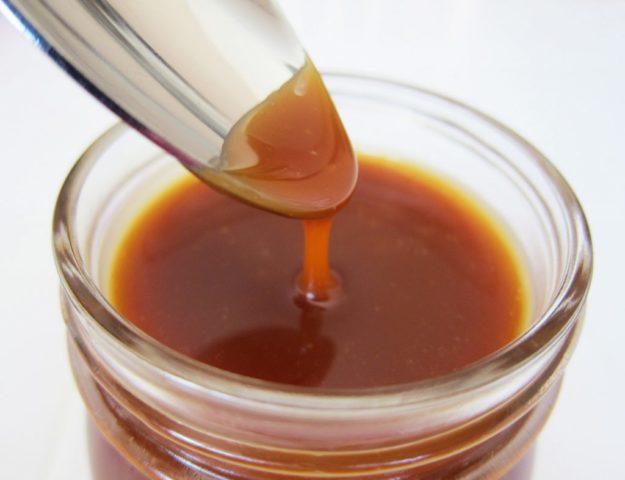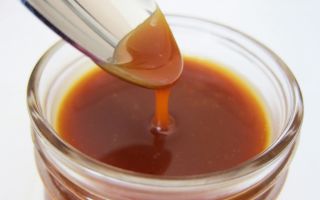Content
Food additive E150a is a special substance obtained as a result of heat treatment of sugar. In food production, it is used as a natural caramel-colored dye. It has spread since the second half of the 19th century.
What kind of additive is E150
Food supplement E150a is in essence burnt sugar. According to its chemical structure, it is classified as natural heteropolymer pigments. The colorant is also called caramel or sugar color. It is presented in the form of a powder or a viscous liquid of dark color. When exposed to sunlight and during heating, the food additive does not change its properties. E150a has a bitter taste in its pure form. It dissolves easily in alcohol and water. In an oil medium, the dye practically does not change its structure. The most common sources of E150 are sugar beets, cornstarch and canes.
The food additive is produced by heating sugar. It can also be made at home. For this, citric acid or juice is used. The mixture is placed on the stove. The longer it is kept on fire, the darker it becomes. The taste characteristics of the substance also depend on this. A dark brown addition will have a characteristic bitterness. The lighter variation E150a has a mild flavor.
The dye and emulsifier E150 is classified according to the complexity of its manufacture. Food supplement E150a is a simple caramel. The production of E150d is carried out using ammonia-sulphite technology. E150b is a caramel made according to the alkaline sulfite scheme. And E150c, in turn, is produced based on the ammonia principle.
Dye composition Sugar color
On an industrial scale, the E150a food additive is produced from sucrose, glucose, fructose, or malt syrup. The colorant can be in powder or liquid structure. A distinctive feature is the characteristic smell of burnt sugar. In addition to the main ingredient, the following substances may be present in the composition:
- ammonium alkali;
- potassium;
- acetic, citric and sulfuric acids;
- calcium;
- sodium.
Is Sugar Color Harmful
E150a dye is approved for use in all countries. Since it is made from natural raw materials, the risk of harmful effects on the human body is minimal. The exception is cases of excessive consumption of products with its content. Uncontrolled intake of food additives in the body can provoke indigestion and flatulence.

Due to its high content of melanin, E150a can contribute to better tan distribution. In addition, the supplement has the ability to protect the body from radioactive radiation. In narrow circles, the substance is considered carcinogenic, but this information has no official confirmation.
For diabetics, the harm of the substance is to stimulate the growth of glucose.In addition, dishes containing sugar color are high in calories. For this reason, excessive consumption of them contributes to weight gain. This is especially dangerous for obese people and those who are attracted to it.
E150d food additive is dangerous or not
In the production of food additive E150d, ammonium salts are used. Due to this, the addition of a substance during production allows to give the product a characteristic caramel shade. It is believed that this type of sugar color is capable of provoking the growth of malignant cells. But the results of many years of research refute this theory. The only danger can lie in the residual salt content. For this reason, it is advisable to choose products containing E150a, and not with its derivatives.
With a moderate intake, the food additive E150d does not have a detrimental effect on human health. Despite this, it is not recommended for use by allergy sufferers and patients with diabetes. In case of metabolic disorders, it can provoke a deterioration in well-being. For people who abuse sweets, the presence of an additive in the composition can result in obesity.
In case of individual intolerance to the substance, the following symptoms may appear:
- skin rash;
- Quincke's edema;
- itchy sensations;
- lacrimation.
With the development of an allergic reaction, you must immediately take an antihistamine and consult a doctor for advice. It is equally important to completely eliminate the product containing the food additive from the diet.
Where and why add dye Sugar color
E150a food additive is used in the production of food products and alcoholic beverages. It gives food its characteristic sweet taste and dark color without causing any harmful effects on health. In some food products, it acts not only as a dye, but also as an emulsifier. In pharmacology, it is used to thicken some of the constituent components. The additive can be found in the following foods:
- confectionery;
- sauces;
- instant broths;
- milk products;
- canned food;
- meat delicacies;
- alcoholic drinks.
Sugar color is added to cognac in order to obtain a noble shade of the drink. At home, three drops of the substance per 1 liter of alcohol are enough. This volume is added in small portions with an exposure time of 10 minutes. An excess of food additive E150a changes the taste of the drink, making it more bitter. In large-scale production, a different ratio of components may be used.
Conclusion
Food additive E150a does not pose a health hazard if used in moderation. It is widely used in food production. The main advantages of the dye and emulsifier include natural origin.

